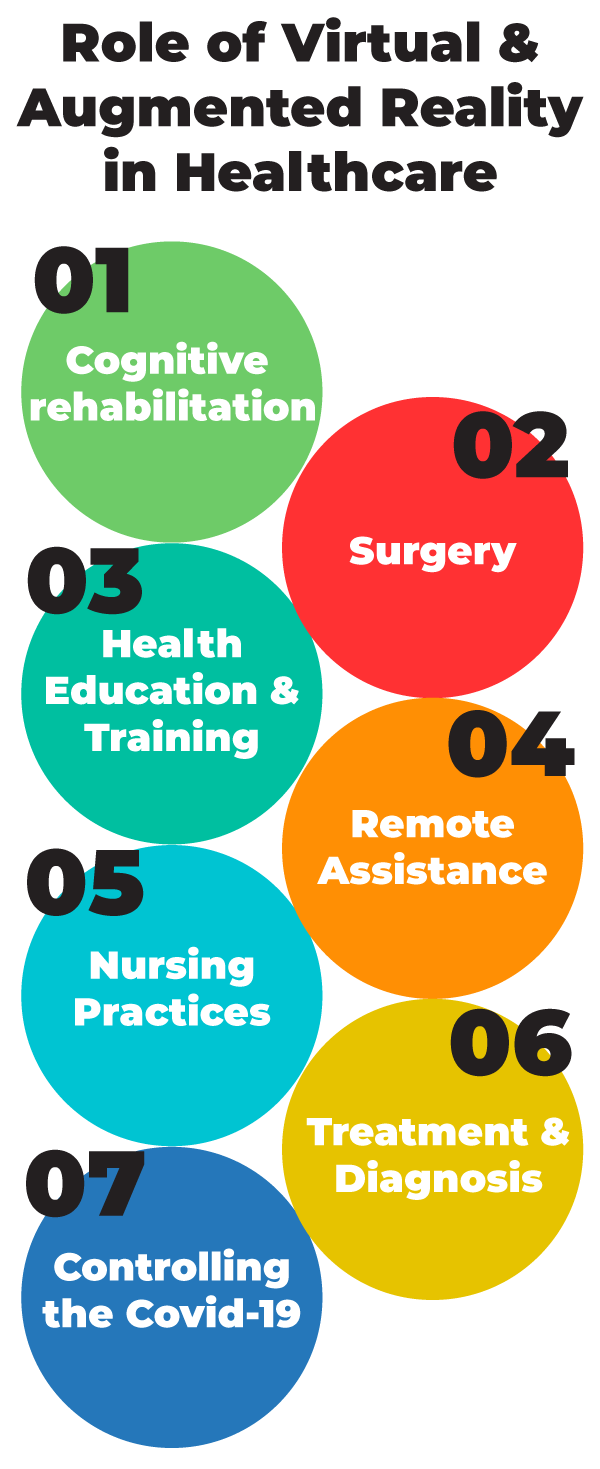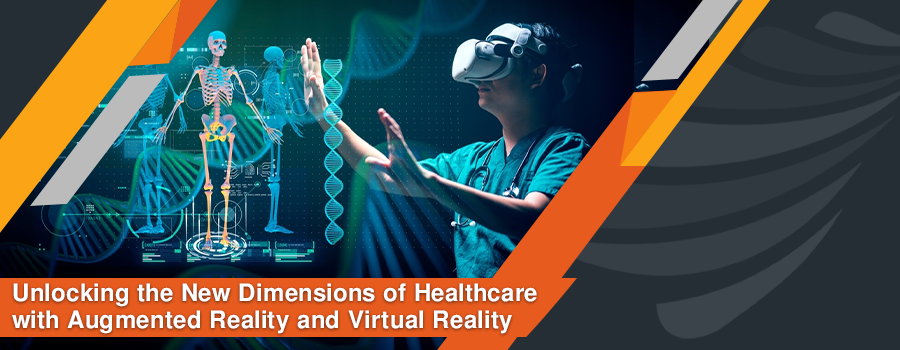In this digital era, people have become addicted to mobiles, laptops, and televisions. Such technologies allow them to connect easily and even do business. Virtual reality (VR) and Augmented Reality (AR) are two advanced technologies changing how we communicate, find enjoyment, make better lives and earn.
VR and AR can give users an experience of digital realms – blur the line between the real and virtual world. VR provides a simulated environment, and AR provides a digital view of the real world. In healthcare, we can use both technologies in many areas, including patient interaction, monitoring surgery, post-operative care, etc.
In this blog, we will understand AR and VR, their healthcare implementation, their challenges, and future aspects.
Understanding Virtual and Augmented Reality
Virtual reality (VR) and Augmented Reality (AR) have changed how we see and interact with the real world.
VR allows you to see a computer-generated world and experience a new perspective. By wearing a headset, it blocks visual stimuli from the real world. You can feel like you are in a new world and gain exciting interactive experiences.
On the other hand, augmented reality (AR) does not take you to a new world, you can see the real world, but it overlays virtual elements. It enhances real-world objects by using computer-generated capabilities. In other words, it allows you to have a wonderful real-world experience using a smartphone or clear visor.
VR enhances the fictional reality and has control over users. At the same time, AI improves both the real and virtual worlds with users’ control of the real world.

Role of Virtual and Augmented Reality in Healthcare
Like every other sector, AR/VR technologies have revolutionized healthcare. It has shown enormous progress in educating, training, and improvising patient experience. Some of the major roles of AR and VR in healthcare are discussed in detail here.
1. Cognitive Rehabilitation
Cognitive Rehabilitation (CR) refers to rehabilitating patients with cognitive difficulties or brain injuries to restore their normal functioning. Among different rehabilitation techniques for such patents, VR is one of the latest technologies. Interactive simulations with computer hardware and software engage patients in an environment similar to the real world.
VR also provides opportunities to imagine, interact and immerse. It can manipulate patients, monitor their behavior and promote their rapid recovery. Recent research has also shown strong evidence that VR is effective in rehabilitating patients with neurological diseases like multiple sclerosis and Parkinson’s disease. It enhances the level of motivation and interest in getting assistance.
On the other hand, AR can merge with physical and virtual working, making it a promising tool for enhancing cognitive rehabilitation procedures. AR also provides patients with personalized training and exercise experiences. They can get memory enhancement therapy, speech therapy, and more in an interactive and visually stimulating environment.
In general, both AR and VR enhance the procedure of conventional therapies with less need to be hospitalized or to attend therapists physically.
2. Surgery
VR allows surgeons to perform surgeries in a virtual platform. The designed software guides them to perform all steps with high accuracy. Also, surgeons from different countries can connect and recommend surgical procedures virtually. In this way, it eliminates the need for patients to visit distant places. One of the latest advancements of VR in surgery is its combination with haptic technology. Doctors can feel like they are handling tools and performing surgery.
Another innovation is VR headsets control surgical robotic systems. The surgical robot operates by copying upper-body movements. For its head, it uses a 360-stereoscopic imaging piece. This hardware piece links with VR devices, making it completely responsive to user movements. In this way, it provides an inside view of a surgical side, eliminating the need for the physical presence of the surgeon.
On the other hand, AR also has improvised surgical procedures. AR healthcare apps help surgeons better understand patient conditions and get advanced assistance. Specifically, AR makes the process seamless and precise in critical situations like minimally invasive procedures or locating tumors. Recent advancements showed that a new software program based on AR has launched. It provides X-ray vision to surgeons by fusing digitally enhanced images directly into the microscope of a surgical device.
Both AR/VR has completely revolutionized surgical practices and helped to achieve fast patient recovery rates.
3. Health Education and Training
In medical education and training, AR/VR plays an enormous role. Students learn by physically experiencing things in an environment that feels real. It allows them to gain tremendous knowledge and training in a short time. Even in situations like the pandemic, it will enable teachers to train and educate students virtually without any hurdles.
One example is by wearing costumes based on a realistic hologram. They can see the inner parts of the human body. Besides this, many other apps and software allow learning practically without facing any hurdles.
Researchers have also reported that the children who get training and education using AR/VR tools are more efficient and have clear knowledge than those who study in classes with only theoretical support.
4. Remote Assistance
One of the best applications of VR is it helps to improvise the life of patients. They can easily interact with their doctors or social workers for support without needing physical presence. They can get training and guidance to improvise their living standards.
They can easily offer precise instructions and real-time advice to patients. Also, they can deal with emergency cases by connecting with family members or social workers.
AR allows health professionals to overlay medical images, real-time information, and patient data for effective consultation. They can improvise patients’ lives by training them to use AR-based mobile apps. It can help them to follow instructions and devise their living standards.
AI/VR keeps patients busy and entertaining by virtually visiting their best places. They can also play games, and do things of their interest. It diverts patients’ attention and keeps them motivated. Also, they reduce patients’ stress levels and even manage chronic pain.
5. Nursing Practices
The implementation of VR/AR in healthcare practices transformed patients’ living standards and made the lives of nurses easier. Nurses easily get training and assistance in a modernized way. It reduces the level of errors in nursing practices as well. For example, the most common mistake is nurses inject the injections in the wrong vein or find it difficult to locate the vein, leading to different issues. The AR-based handheld scanner allows the nurses to put it over the patient’s skin and easily visualize the veins.
On the other hand, VR simulations allow nurses to experience different real-life scenarios in which they can feel and explain their actions. They can also experience virtual systems where they can be put as patients to understand their needs and sufferings. In this way, nurses can give their best by understanding patient conditions in the best way.
6. Treatment and Diagnosis
AR/VR now plays a major role in correct diagnosis and rapid treatment. They can use advanced software to evaluate patient data, medical images, and other relevant information. With visual simulations, they can plan treatments, detect anomalies, evaluate different scenarios the patient can face, and implement various techniques to experience the results. In this way, they can select the best procedure.
Conversely, it is difficult for doctors to explain the benefits of a particular treatment or surgical procedure. VR/AR allows them to easily define them by giving them virtual or augmented reality experiences. It enables them to visualize and help them to make the right decision with complete satisfaction and trust.
7. Controlling the Covid-19
Covid-19 is one of the most critical challenges for the worldwide healthcare industry. AR/VR implementations in such situations help to estimate the total number of vaccines, injections, and equipment needed. It helps to provide training to volunteers without the spread of diseases. Also, AR/VR monitoring tools allow nurses to monitor patients and examine their records.
On the other hand, AR/VR implementations helped spread awareness and made people understand the importance of following Standard Operation Procedures (SOP).
In this way, the implementation greatly helped control the pandemic situation.
Challenges in the Implementation of AR and VR in the Healthcare
One of the major challenges in implementing AR and VR in healthcare is the high initial cost. There is a lack of awareness and training. Therefore, people hesitate to invest in it. Hospitals do not have proper infrastructure and planning for implementation. Also, there is a lack of proven AR/VR healthcare models to ensure the effectiveness and benefits we can gain after investing time and money.
Other than this, healthcare professionals and technicians do not have the proper training and education to use it. There are also many misconceptions among patients; therefore, many are not ready to use or learn from it.
The patients’ major concerns are security, privacy, and standards. There are no standards and regulations on what is allowed and not allowed to use or explored via AR/VR applications. There are concerns that people may misuse data to humiliate or damage the reputation of someone. Furthermore, via data mining and surveillance, people can hijack accounts by manipulating digital content.
Implementing AR and VR is a more sensitive topic than ever imagined. Therefore, we need strong backup support from developers with high protocols, policies, and regulations to experience its positive expectations.
Upcoming AR and VR Updates in Healthcare
In healthcare practices, we have been using AR/VR since 2010. With time, the implementation was improvised and explored in various domains. Now, we have started to take huge opportunities via the application of AR and VR, and the research is still going on.
One breakthrough is mixed reality, which eliminates the boundaries between AR and VR. It blends the real and digital worlds. One of the major examples of its implementation is HoloLense. It lets you experience virtual 3d things or people in a real environment. You can interact with the physical environment and realistically move around 3-dimensional projections.
In healthcare, we are exploring huge implementations of hologram technology. For example, holograms can provide 3d visualization during surgeries, X-rays, and ultrasounds, assisting healthcare professionals to make better decisions.
The future of AR/VR is healthcare has no limit. The technologies are upgrading and integrating with other advanced technologies like artificial intelligence, the Internet of Things, 5g, and 6g. That’s why we can expect exciting applications in the upcoming time.
These inventions will not only comfort life and simplify the healthcare process but also improve health conditions. They also make the treatment options possible for diseases that do not still have any cure or treatment.
Conclusion
AR and VR have enormous applications in healthcare. From patient consultation to remote assistance, it can completely revolutionize the patient experience of healthcare. Also, it assists doctors in training and education to help them give their best for patient treatment and recovery. Even out of the city, they can remotely deal with cases. They can also understand critical instances in a better way with virtual simulations, AR apps, and holography. It is important to note that there are several concerns and challenges in implementing AR/VR in healthcare. Therefore, we must put in extensive research and efforts to experience its positive aspects and improve our healthcare experience.





